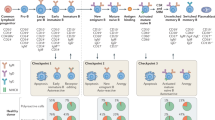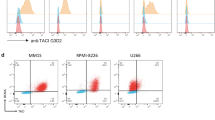Abstract
Models for immune-mediated tumor regression in mice have defined an essential role for cytotoxic T lymphocytes (CTLs); however, naturally occurring tumor immunity in humans is poorly understood 1 . Patients with paraneoplastic cerebellar degeneration (PCD) provide an opportunity to explore the mechanisms underlying tumor immunity to breast and ovarian cancer. Although tumor immunity and autoimmune neuronal degeneration in PCD correlates with a specific antibody response to the tumor and brain antigen cdr2 2, 3 , this humoral response has not been shown to be pathogenic 3, 4 . Here we present evidence for a specific cellular immune response in PCD patients. We have detected expanded populations of MHC class I-restricted cdr2-specific CTLs in the blood of 3/3 HLA-A2.1 + PCD patients, providing the first description, to our knowledge, of tumor-specific CTLs using primary human cells in a simple recall assay. Cross-presentation of apoptotic cells by dendritic cells also led to a potent CTL response. These results indicate a model whereby immature dendritic cells that engulf apoptotic tumor cells can mature and migrate to draining lymph organs where they could induce a CTL response to tissue-restricted antigens. In PCD, peripheral activation of cdr2-specific CTLs is likely to contribute to the subsequent development of the autoimmune neuronal degeneration.
This is a preview of subscription content, access via your institution
Access options
Subscribe to this journal
Receive 12 print issues and online access
$209.00 per year
only $17.42 per issue
Buy this article
- Purchase on Springer Link
- Instant access to full article PDF
Prices may be subject to local taxes which are calculated during checkout



Similar content being viewed by others
References
Schuler, G. & Steinman, R.M. Dendritic cells as adjuvants for immune-mediated resistance to tumors. J. Exp. Med. 186, 1183–1187 (1997).
Boon, T. & Old, L.J. Cancer tumor antigens. Curr. Opin. Immunol. 9, 681–683 (1997).
Darnell, R.B. Onconeural antigens and the paraneoplastic neurologic disorders: at the intersection of cancer, immunity and the brain. Proc. Natl. Acad. Sci. USA 93, 4529–4536 (1996).
Furneaux, H.L., Reich, L. & Posner, J.P. Autoantibody synthesis in the central nervous system of patients with paraneoplastic syndromes. Neurology 40 , 1085–1091 (1990).
Dropcho, E., Chen, Y., Posner, J. & Old, L. Cloning of a brain protein identified by autoantibodies from a patient with paraneoplastic cerebellar degeneration. Proc. Natl. Acad. Sci. USA 84, 1–5 (1987).
Fathallah-Shaykh, H., Wolf, S., Wong, E., Posner, J. & Furneaux, H. Cloning of a leucine-zipper protein recognized by the sera of patients with antibody-associated paraneoplastic cerebellar degeneration. Proc. Natl. Acad. Sci. USA 88, 3451– 3454 (1991).
Sakai, K., Mitchell, D.J., Tsukamoto, T. & Steinman, L. Isolation of a complementary DNA clone encoding an autoantigen recognized by an anti-neuronal antibody from a patient with paraneoplastic cerebellar degeneration. Ann. Neurol. 28, 692– 698 (1990).
Corradi, J.P., Yang, C.W., Darnell, J.C., Dalmau, J. & Darnell, R.B. A post-transcriptional regulatory mechanism restricts expression of the paraneoplastic cerebellar degeneration antigen cdr2 to immune privileged tissues. J. Neurosci. 17, 1406–1415 (1997).
Peterson, K., Rosenblum, M.K., Kotanides, H. & Posner, J.B. Paraneoplastic cerebellar degeneration. I. A clinical analysis of 55 anti-Yo antibody-positive patients. Neurology 42, 1931–1937 (1992).
Bender, A., Sapp, M., Schuler, G., Steinman, R.M. & Bhardwaj, N. Improved methods for the generation of dendritic cells from nonproliferating progenitors in human blood. J. Immunol. Methods 196, 121–135 ( 1996).
Albert, M.L., Sauter, B. & Bhardwaj, N. Dendritic cells acquire antigen from apoptotic cells and induce class I- restricted CTLs. Nature 392, 86–89 (1998).
Bennett, S.R. et al. Help for cytotoxic-T-cell responses is mediated by CD40 signalling. Nature 393, 478–80 (1998).
Boon, T., Cerottini, J.C., Van den Eynde, B., van der Bruggen, P. & Van Pel, A. Tumor antigens recognized by T lymphocytes. Ann. Rev. Immunol. 12, 337–365 (1994).
Carmichael, A., Jin, X., Sissons, P. & Borysiewicz, L. Quantitative analysis of the human immunodeficiency virus type 1 (HIV- 1)-specific cytotoxic T lymphocyte (CTL) response at different stages of HIV-1 infection: differential CTL responses to HIV-1 and Epstein- Barr virus in late disease. J. Exp. Med. 177, 249–56 (1993).
Koup, R.A. et al. Limiting dilution analysis of cytotoxic T lymphocytes to human immunodeficiency virus gag antigens in infected persons: in vitro quantitation of effector cell populations with p17 and p24 specificities. J. Exp. Med. 174, 1593–1600 (1991).
McMichael, A. Cytotoxic T lymphocytes specific for influenza virus. Curr. Top. Microbiol. Immunol. 189, 75–91 (1994).
Darnell, R.B. & DeAngelis, L.M. Regression of small-cell lung carcinoma in patients with paraneoplastic neuronal antibodies. Lancet 341, 21–22 ( 1993).
Devita, V.T., Hellman, S. & Rosenberg, S. in Cancer, Principles and Practice of Oncology, 1930–1931 (J.B. Lippincott, Philadelphia, 1989).
Huang, A.Y. et al. Role of bone marrow-derived cells in presenting MHC class I-restricted tumor antigens. Science 264, 961–5 (1994).
Zitvogel, L. et al. Therapy of murine tumors with tumor peptide-pulsed dendritic cells: dependence on T cells, B7 costimulation, and T helper cell 1-associated cytokines. J. Exp. Med. 183, 87– 97 (1996).
Dalmau, J. et al. Major histocompatibility proteins, anti-Hu antibodies, and paraneoplastic encephalomyelitis in neuroblastoma and small cell lung cancer. Cancer 75, 99–109 (1995).
Strand, S. et al. Lymphocyte apoptosis induced by CD95 (APO-1/Fas) ligand-expressing tumor cells—a mechanism of immune evasion? Nature Med. 2, 1361-1366 (1996).
Corriveau, R.A., Huh, G.S. & Shatz, C.J. Regulation of class I MHC gene expression in the developing and mature CNS by neural activity. Neuron 21, 1–20 (1998).
Bhardwaj, N. et al. Influenza virus-infected dendritic cells stimulate strong proliferative and cytolytic responses from human CD8+ T cells. J. Clin. Invest. 94, 797–807 (1994).
Barouch, D. et al. HLA-A2 subtypes are functionally distinct in peptide binding and presentation. J. Exp. Med. 182, 1847 –56 (1995).
Acknowledgements
We thank the staff of the Rockefeller Hospital GCRC, particularly M. McNiff and M. Keogh, for facilitating the patient studies. We thank E. Albert for help in patient recruitment. We thank R. Steinman, E. Gotschlich and members of our laboratories for discussions and review of the manusript. Support from the Department of Defense (Breast Cancer Research Award #DAMD017-94-J-4277), the National Multiple Sclerosis Society (PP0507), and the NIH Medical Scientist Training Program grant (GM-07739) is acknowledged. Clinical work at the RU Hospital GCRC was supported through grant M01 RR00102, and approved by institutional IRB #RDA-148. N.B. was supported by NIH grant AI-39516 and grants from the SLE Foundation.
Author information
Authors and Affiliations
Corresponding author
Rights and permissions
About this article
Cite this article
Albert, M., Darnell, J., Bender, A. et al. Tumor-specific killer cells in paraneoplastic cerebellar degeneration . Nat Med 4, 1321–1324 (1998). https://doi.org/10.1038/3315
Received:
Accepted:
Issue Date:
DOI: https://doi.org/10.1038/3315
This article is cited by
-
A Pilot Study to Develop Paraneoplastic Cerebellar Degeneration Mouse Model
The Cerebellum (2023)
-
The current landscape of immunotherapy for pediatric brain tumors
Nature Cancer (2022)
-
Rapid-onset paraneoplastic cerebellar degeneration successfully treated by radiotherapy and tumorectomy
International Cancer Conference Journal (2022)
-
Paraneoplastic neurological syndromes associated with non-Hodgkin lymphoma: a case series
Neurological Sciences (2022)
-
Novelties in Autoimmune and Paraneoplastic Cerebellar Ataxias: Twenty Years of Progresses
The Cerebellum (2022)



